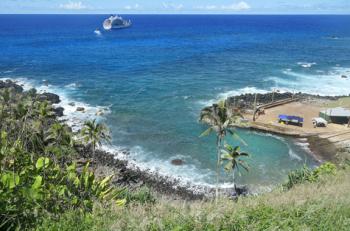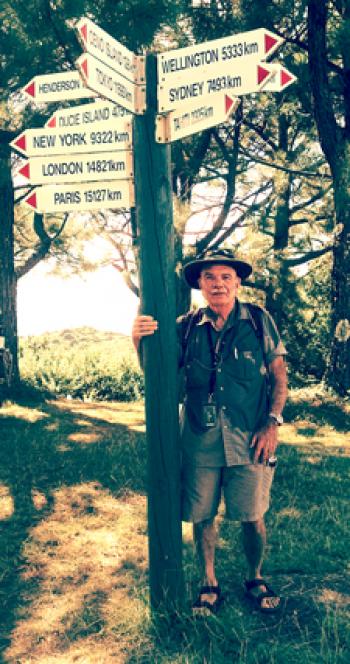Pitcairn Island visit
This item appears on page 12 of the October 2019 issue.
My wife, Betsy, and I participated in the initial voyage of the “passenger/freighter” M/V Aranui 5 from Tahiti to Pitcairn Island, Jan. 10-22, 2019.
We saw many interesting cultural, archaeological and geological features on the atolls of Tahanea and Amanu in the Tuamotu archipelago, on the Gambier islands of Mangareva and Aukena and on the Austral islands of Rapa and Raivavae — all part of French Polynesia. Residents of these islands welcomed us with music, dancing and food, all of which were good.
Betsy has trouble deciding which island she liked best: Rapa or Raivavae. The people of Rapa provided our Polynesian Night entertainment aboard the ship, but she says Raivavae was over the top!
However, I say the high point of the trip was the stop at Pitcairn Island, the only British overseas territory in the South Pacific. Mutineers from HMS Bounty, led by Fletcher Christian, arrived there in 1790, and descendants of the mutineers and their Tahitian mates live there today. This history and culture — along with the unique location, topography and geology — made Pitcairn Island special for me.
One of the most remote inhabited islands in the world, Pitcairn is located about 1,340 miles southeast of Tahiti, 1,290 miles west of Easter Island and 3,100 miles northeast of New Zealand. The nearest airport, with one flight per week from Pape ete, Tahiti, is 330 miles away on Mangareva, in the Gambier Islands. A supply-and-passenger ship from Mangareva visits Pitcairn Island every two weeks. Cruise ships and yachts visit occasionally.
Due to the rocky shore and rough seas, though, ships anchor a half-mile offshore and transfer supplies and passengers ashore in small boats. When seas are too rough, however, those are not able to reach land.
The island is approximately 2 miles long by 1 mile wide, with a maximum elevation of 1,138 feet. A young volcanic island built up from the sea floor over the past 11 million years, Pitcairn is the remnant of a shield volcano with a collapsed caldera, a faulted and dissected caldera rim and steep cliffs on all sides.
The climate is tropical, with an annual rainfall of 63 to 79 inches, according to different references. Residents collect roof runoff in cisterns and tanks for their water supply. Not available 24 hours a day, electricity is supplied days and evenings by diesel generators.
Fifty people, including three children, live on the island. Most are descendants of the Bounty mutineers. Tourism is the main economic activity there, but there aren’t many visitors.
There is one paved road, 4 miles long, stretching from the landing at Bounty Bay up the Hill of Difficulty to the capital of Adamstown and beyond. There are a few cars, but the common way to get around is by ATV or walking.
Several unpaved roads and trails lead to points of interest, including the Eco Trail to Christian’s Cave, where Fletcher watched for British warships.
We were allowed to go ashore all day on the 15th and on the morning of the 16th. The island’s inhabitants were overwhelmed when the ship’s 200 passengers (out of a capacity of 258) and many of the 64 crew members disembarked. Three ceremonial breadfruit trees from Tahiti were planted, crew members provided lunch from the ship, and there was an opportunity to explore the island.
I was among passengers who returned in the morning for further exploration. Others stayed on the ship for a lecture about life on Pitcairn by a 20-year nonnative resident.
A day and a half on Pitcairn was enough to get the feel of the place and know that we wouldn’t want to stay there for two weeks between ships from Mangareva, as some people do.
Pitcairn and three nearby uninhabited islands have great biodiversity, with rare and endangered flora and fauna. In 2016, the British government established the Pitcairn Islands Marine Reserve. Covering 324,000 square miles, it is one of the world’s largest protected expanses of sea.
Including a 10% discount as repeat Aranui passengers, our Standard Stateroom cost Betsy and me $4,842 per person. The fare included all food and beverages (wine at lunch and dinner) and twice-weekly laundry service. Traveling in business class on American Airlines and Air Tahiti Nui added about $7,200 each.
We booked our Aranui 5 cruise with Compagnie Polynésienne de Transport Maritime (San Mateo, CA; 800/972-7268, aranui.com).
JIM HAMEL
Monroeville, PA


